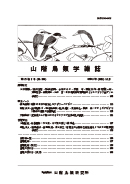Current issue
Displaying 1-6 of 6 articles from this issue
- |<
- <
- 1
- >
- >|
Original Article
-
2023 Volume 55 Issue 2 Pages 103-113
Published: December 25, 2023
Released on J-STAGE: December 17, 2023
Download PDF (1706K)
Letters
-
2023 Volume 55 Issue 2 Pages 115-122
Published: December 25, 2023
Released on J-STAGE: December 17, 2023
Download PDF (1856K) -
2023 Volume 55 Issue 2 Pages 123-130
Published: December 25, 2023
Released on J-STAGE: December 17, 2023
Download PDF (799K) -
2023 Volume 55 Issue 2 Pages 131-136
Published: December 25, 2023
Released on J-STAGE: December 17, 2023
Download PDF (786K)
Materials
-
2023 Volume 55 Issue 2 Pages 137-151
Published: December 25, 2023
Released on J-STAGE: December 17, 2023
Download PDF (816K) -
2023 Volume 55 Issue 2 Pages 152-155
Published: December 25, 2023
Released on J-STAGE: December 17, 2023
Download PDF (1233K)
- |<
- <
- 1
- >
- >|
